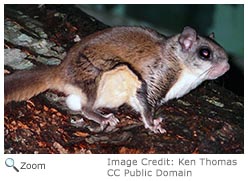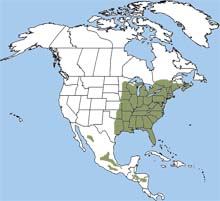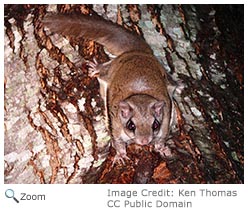Characteristics  The southern flying squirrel is smaller than the northern flying squirrel. It is about seven to ten inches in length. It has thick, silky grayish-brown fur above and white fur below. It has very large eyes and a long, flat tail. It has a loose fold of skin between its front and rear feet. When it stretches out its legs, this skin forms a kind of parachute that lets the squirrel glide from branch to branch. As the southern flying squirrel approach its landing site, it pulls up, slowing its descent! When it is gliding, it uses its tail as a rudder to change direction! The southern flying squirrel is smaller than the northern flying squirrel. It is about seven to ten inches in length. It has thick, silky grayish-brown fur above and white fur below. It has very large eyes and a long, flat tail. It has a loose fold of skin between its front and rear feet. When it stretches out its legs, this skin forms a kind of parachute that lets the squirrel glide from branch to branch. As the southern flying squirrel approach its landing site, it pulls up, slowing its descent! When it is gliding, it uses its tail as a rudder to change direction!
Range
 The southern flying squirrel is found from Texas, Kansas and Minnesota east through most of the eastern United States. It is also found in southeastern Canada and in Mexico and Central America. The southern flying squirrel is found in New Hampshire. The southern flying squirrel is found from Texas, Kansas and Minnesota east through most of the eastern United States. It is also found in southeastern Canada and in Mexico and Central America. The southern flying squirrel is found in New Hampshire.
Habitat
The southern flying squirrel lives in deciduous and mixed forests with lots of old trees with cavities for nesting. They especially like areas with seed bearing hardwood trees like hickory, maple, beech and poplar.
|
|
Diet
 The southern flying squirrel eats berries,
seeds, fruits, lichen, tree bark, buds and nuts. It also eats insects,
carrion, nesting birds and eggs. It stores nuts and seeds in the ground and in crevices and holes in trees for use in winter. The southern flying squirrel eats berries,
seeds, fruits, lichen, tree bark, buds and nuts. It also eats insects,
carrion, nesting birds and eggs. It stores nuts and seeds in the ground and in crevices and holes in trees for use in winter.
Life Cycle
The southern flying squirrel mates in early spring and again in late summer. After a gestation period of 41 days, the female gives birth to two to seven young. The female feeds and raises the young. She will move them to another nest if she feels threatened. The young are weaned when they are about 65 days old and begin gliding when they are about five to six weeks old. They are independent when they are about four months old.
Behavior
 The southern tree squirrel is nocturnal.
It usually builds its nest in a tree cavity or abandoned woodpecker hole,
but it will sometimes use leaves, bark and twigs to make a nest in a tree
crotch. It doesn't hibernate, but in the winter it may stay in its den
huddled with a group of other squirrels to keep warm. The southern tree squirrel is nocturnal.
It usually builds its nest in a tree cavity or abandoned woodpecker hole,
but it will sometimes use leaves, bark and twigs to make a nest in a tree
crotch. It doesn't hibernate, but in the winter it may stay in its den
huddled with a group of other squirrels to keep warm.
|